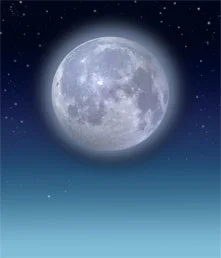Our planet, Earth, has one natural satellite, the Moon.
The moon is 384,400 kilometres from Earth.
The moon is the second brightest object in our sky after the Sun.
The Moon has had many names throughout history, including Luna (ancient Roman) and Artemis (ancient Greek). The dark marks we can see from Earth were once thought by the astronomer Galileo to be seas on the Moon, and even though we know there is no water on the Moon, the names have been kept.
A full moon. Getty
The Moon orbits around the Earth, taking one month to complete an orbit. This movement around the Earth makes it look to us as if the moon changes shape from a full round circle to a thin crescent. We can see the moon when we look in the sky. Sometimes it looks like a big round ball. That is called the full moon. Sometimes it looks like half a circle. Sometimes it looks like a thin slice. These are called the Phases of the Moon.
The Moon does not have any atmosphere so it gets much much hotter and colder than Earth does. On the side of the Moon that the Sun shines on, temperatures can reach almost 127ºC.
A crescent moon ©Getty
On the dark side, where the sunlight does not reach, temperatures are very cold, -128ºC. No atmosphere means no weather.
There is a gravitational pull between the Earth and the Moon, which causes the ocean tides on Earth.
The Moon’s surface is rocky and dusty, pitted with craters where meteors have crashed.
Eclipses
A solar eclipse ©Getty
Sometimes the orbits of Earth and Moon coincide so that the Moon is directly in between the Earth and the Sun, blocking part of the Sun's light from the Earth.
This is called a solar eclipse.
On rare occasions, the Sun and the Moon are in a perfect line, which is called a total eclipse.
Sometimes their orbits coincide so that the Earth is directly between the Sun and the Moon, so the light from the Sun doesn't reach the Moon. This is a lunar eclipse. During the eclipse, we can see Earth's shadow on the Moon.
The Humans land on the Moon
On 20 July 1969, the Apollo 11 Lunar Landing Module landed on the surface of the Moon, in the Sea of Tranquility. Astronaut Neil Armstrong was the first human to step onto the Moon, later joined by astronaut Buzz Aldrin.
It’s a good idea to get information from more than one source!
Read more about the moon
https://www.sciencekids.co.nz/sciencefacts/space/moon.html
https://www.factsjustforkids.com/planet-facts/earth-facts-for-kids/earth-moon-facts/
Read about the first landing on the moon
https://www.tutordoctor.com/blog/2021/june/5-fascinating-facts-about-the-1969-moon-landing-/
https://kids.nationalgeographic.com/history/article/moon-landing
Watch a video about the moon
What is an eclipse of the moon? Watch an animation that answers the question!
https://www.neok12.com/video/Eclipse/zX45704e56606151726a0377.htm







